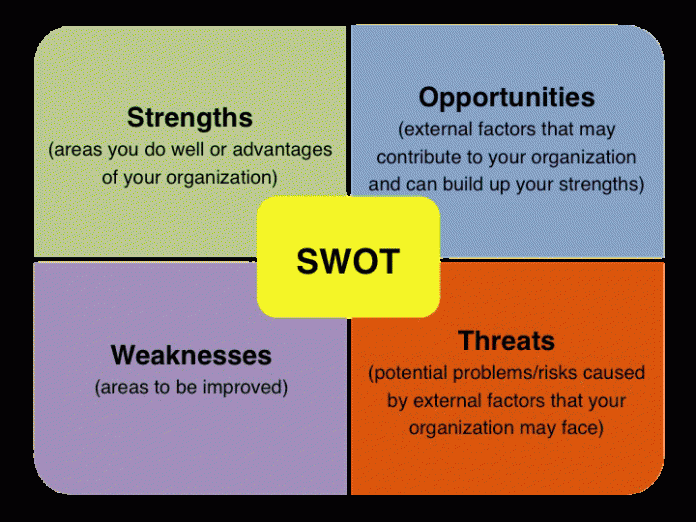If you’re a freelancer, odds are you’ve worked with clients that needed some help on the strategic end before they even tapped into your core skill set. And if you haven’t had that experience yet, don’t worry: you will.
The fact is, some clients don’t know the best way to grow their business; or if they do, they don’t quite know how to get there. That’s where your expertise can prove to be invaluable. And if your client has hired you in a consulting role — or if they’re willing to listen to your insights in general — then it may be time to whip out a SWOT analysis from your strategic planning “toolbox.”
The acronym SWOT stands for strength, weakness, opportunity, and threat. Let’s talk about what is included in each of these elements, and how you can determine your client’s current position on all four counts. And if you need some help organizing your SWOT analysis, check out some helpful SWOT templates and worksheets.
Strength
The first two elements of a SWOT analysis (strength and weakness) are internal factors. Obviously, your client’s strengths are the internal advantages that the company owns, especially in comparison to the competition.
Strengths can include a wide range of components, such as a long-standing reputation in the local community, a large amount of capital, an effective pricing strategy, an engaging marketing campaign… the list could go on and on. For example, if your client is a law firm that’s been in business for 20+ years, then one of their strengths may be a wealth of social proof (4 and 5-star reviews, case studies, testimonials, and so forth). On the other hand, a new SaaS startup funded by private investors may have a lot of capital to work with.
How can you determine your client’s areas of strength? One of the best ways to assess this element is to ask your client’s management group for their observations. For example, ask questions such as: “What is your company good at? What resources does it have at its disposal?” If you have access to past or current customers of the client, reach out to them for feedback as well.
Weakness
Here we have the other side of your client’s “internal coin,” so to speak. Areas of weakness include any internal factors that limit the client’s ability to reach business objectives, or achieve the client’s overarching “vision.”
Common examples of weakness include lack of resources, lack of market penetration, inefficient business processes, poor reputation management, etc. If we take the example of the law firm mentioned above a step further, then an area of weakness may be limited market reach (the firm advertises in the local newspaper and over the radio, but hasn’t set up a dedicated website yet).
To determine your client’s weaknesses, you may need to ask management some penetrating questions, such as: “Where is your company lagging behind? What value do your competitors offer that you don’t? Which of your business operations yield a below-average ROI?” If you’re able to conduct some interviews with company employees, then you’ll likely find that feedback “direct from the employee’s mouth” will also show up some inefficiencies.
Opportunity
The final two elements of the SWOT analysis are largely focused on external factors. The first of these is all about finding opportunities for growth. This can include opportunities that open up within the industry in general, opportunities that are specific to a geographical area or market “niche,” and opportunities that arise from technological advances and innovations.
Some examples of opportunity areas from different industries include:
- A damaging hailstorm for roofing companies (contractors will have more repair work lined up)
- A significant new update in Google’s SERP algorithm (SEO experts that stay on top of the update will be more valuable to prospective clients)
- A certain area trending towards a “retirement community” (there will be more demand for attorneys that specialize in real estate, estate planning, etc.)
In order to accurately gauge the potential associated with a market opportunity, you’ll have to perform some market research (think competitor pricing, development of buyer personas, and focused interviews if possible). You may also need a solid understanding of your client’s industry in terms of government regulations and other factors that could limit the impact of a new initiative.
Threat
Last but not least, the “Threat” section of your SWOT analysis is designed to identify current and emerging risk factors, both in the client’s industry as a whole, and also in terms of the client’s specific audience/geographical region. As with the previous 3 elements, threats can include a wide range of factors — anything from new, disruptive technologies to market saturation to economic downturns to rising costs for material and labor.
For example, threats can include situations such as:
- Market saturation due to increased demand (a damaging hailstorm causes a sharp increase in the amount of roofing contractors within a certain community)
- New offerings or innovations from the competition (three words for you: Walkman, meet iPod)
- Economic upheaval (remember how the real estate bubble burst in 2008?)
How can you determine which threats pose the greatest risk for your client? Again, market research is key. Along with that, a detailed analysis of your client’s main competitors will likely yield several key insights. While not every threat can be foreseen, doing your due diligence can give your client a good idea of where the primary risks lie as the company moves forward.
Use a SWOT Analysis to Help Your Client Make Good Decisions
In the end, a SWOT analysis can be an excellent technique to help your client set priorities, understand risks, improve internal processes, and leverage their strengths. As you walk your client through this comprehensive analysis and guide him/her to actionable conclusions, you’ll demonstrate your value to the company, and no doubt enhance your reputation as a freelancer.




